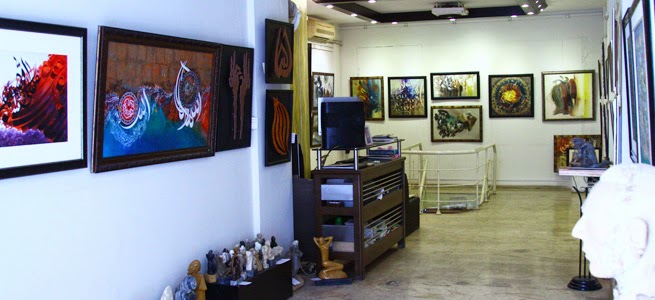Poster artist Sarfraz Iqbal talks about his craft and passion. PHOTOS: MALIK SHAFIQ/EXPRESS
LAHORE:
In a small office in Lahore’s film district Royal Park,
painter Sarfraz Iqbal is as busy at work as ever. The 68-year-old, who
is also known as S Iqbal, has been designing and painting film posters
for decades but his name often goes unnoticed. His iconic work includes
painting of veterans Waheed Murad and Rangeela, to the more recent ones
such as Zinda Bhaag and Ishq Khuda. This legend of an
artist deserves more credit and recognition than he is given as he is
currently the last of traditional poster artists the city has to offer.
“Back in the day, posters would be made by hand. It’s one of the
hardest jobs when it comes to the publicity of a film,” Iqbal
reminisces. “Waheed Murad had become very concerned about his age. By
the end, as his popularity was shifting away, he became quite conscious
of himself. He wanted to look 15 years younger. But Nadeem never had
that issue.” Iqbal admits it was his duty to make actors look “as
beautiful as possible through these posters”.Painting film posters was in the genes, it appears. Iqbal’s father Sardar Khan, aka S Khan, was another well-known poster artist who worked in Bombay well before partition. After he migrated to Lahore, he became the pioneer of cinema publicity in Pakistan.
Poster artist Sarfraz Iqbal talks about his craft and passion. PHOTOS: MALIK SHAFIQ/EXPRESS“He made [painted] posters of all the biggest films in the country — he had sort of a monopoly at the time,” Iqbal says about his father, adding posters back then were the main tool of promotion. S Khan not only inspired his son, but a generation of upcoming painters who worked with leading film-makers later on, as well.
Iqbal admits pursuing this option as a career was always part of the plan for him. By the time he reached the eighth grade, he started to work full-time developing posters for some of the best directors in the country. In 1962, he became the leading artist of Lollywood and by the ‘70s, he was making posters for nearly 50% of all films that were produced.
His first film poster was of a Punjabi film, Khan recalls. “What I did was unlike anything. I would pull out those scenes which had a very important role in the film or a scene that would speak out to the audience,” he explains his reasoning behind painting a specific scene from the movie. Designing hand-made posters, large or medium, is time-consuming and can even take months. Thus, Iqbal spent hours planning, drawing and painting posters on a wooden desk — a special desk he still owns today.
“There was not an hour where I would be free,” the artist confesses. “I would be working late at night but, at that time, there was respect for this craft. And not just for me, there were other artists as well.”
Khan has designed posters for several directors including veterans such as WZ Ahmed and Nazarul Islam but admits that his favourite poster till date — which hangs in a small room in his office — is the one of Mohammad Ali with Shabnam for 1987 Sajjad Gul film Dooriyan.
“This picture was important to me because I had made Mohammad Ali look negative, and Shabnam positive,” he explains. “It was something different from what had been ever done before.” He admits that working with any director for the first time is always difficult as they have something specific in mind, yet Khan was always focused on his craft and creating a piece that would be great.
His prolific career and portfolio only recently caught the attention of film fanatics who are now trying to preserve his work. Director of Zinda Bhaag Farjad Nabi made a documentary on Khan’s life called The Final Touch, which was screened at the Kara Film Festival in 2006.
“I never thought of keeping a record. I was doing so much, I just never thought of it,” he continues. “Now, we are trying to find many of these posters.” Art professor Durriya Qazi of Karachi University has started to collect his paintings in the hope of preserving them and possibly developing a record.
Even today, Javed Sheikh, Syed Noor, Shehzad Gul and Shehzad Rafique and many of the newer lot, all continue to use Iqbal’s art as a staple in any production they are a part of.
Published in The Express Tribune, November 4th, 2013.
Like Life & Style on Facebook, follow @ETLifeandStyle on Twitter for the latest in fashion, gossip and entertainment.
Read more:
Lahore



.jpg)








.jpg)
.jpg)

.jpg)


.jpg)

.jpg)





